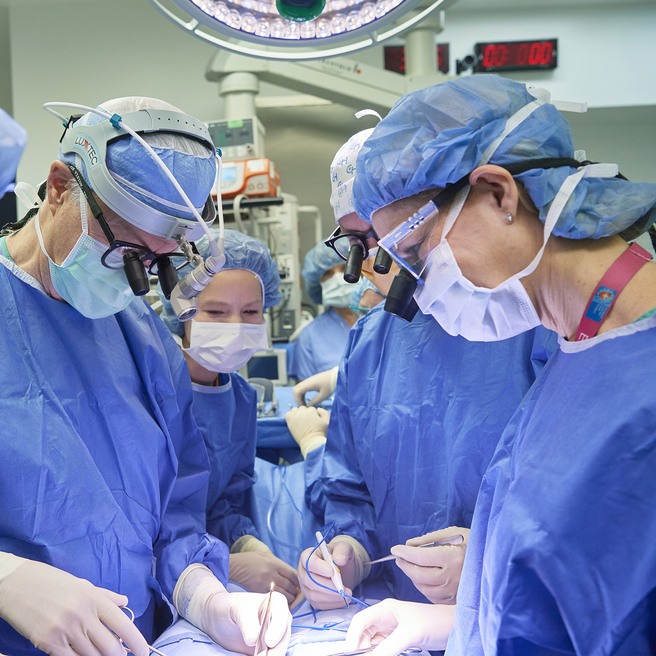What is congenital high airway obstruction syndrome (CHAOS)?
Congenital high airway obstruction syndrome (CHAOS) is a term used to describe a rare congenital anomaly (present before birth) characterized by a blockage of the airway. The CHAOS term was coined by Marcelo Martinez-Ferro, MD, and N. Scott Adzick, MD, in 1994.
This blockage can occur in different areas along the airway and causes fluid to become trapped in the unborn baby’s lungs. Since the fetal lungs produce fluid under positive pressure before birth, the lungs get very large and overinflated and consequently compress the heart, which cannot function normally. This then leads to an accumulation of free fluid in various fetal compartments, including the abdomen (ascites) as well as skin and scalp, which is also known as hydrops.
CHAOS is associated with a variety of conditions that can obstruct the trachea, such as:
- Laryngeal atresia – Partial development of the voice box with an interruption or blockage. This is the most common obstruction leading to CHAOS
- Tracheal atresia – Partial development of the windpipe with an interruption or blockage
- Tracheal agenesis – Complete absence of the windpipe (trachea)
- Tracheal stenosis – Narrowing or stricture of a segment of the upper airway at the trachea or the larynx
- Fluid-filled cyst blocking the trachea or larynx
- Web-like membrane obstructing the trachea or larynx
All suspected cases of CHAOS should be carefully evaluated by an experienced multidisciplinary team. Determining the type and location of the blockage will guide treatment strategies. While CHAOS is life-threatening if left untreated, advances in prenatal imaging and management have improved outcomes.
Causes of CHAOS
The underlying cause of CHAOS is unknown.
Congenital high airway obstruction syndrome can be related to genetic or chromosome differences such as Fraser syndrome or 22q11.2 deletion syndrome, among others. For this reason, it is important to consider genetic testing on the fetus in the form of an amniocentesis. Cases of isolated CHAOS without evidence of chromosomal or genetic causes are felt to be sporadic with no increased recurrence risk.
Signs and symptoms of CHAOS
Signs of CHAOS are typically discovered on a routine prenatal ultrasound:
- The fetal lungs appear enlarged and bright (echogenic) on both sides with prominent airways (dilated bronchial tree)
- The diaphragm (breathing muscle) is pushed downward
- The heart appears compressed and shifted to the middle of the chest
- There is fluid accumulation in the fetal abdomen (ascites) and potentially other fetal compartments (hydrops)
- The amniotic fluid may be increased (polyhydramnios) due to compression of the esophagus (swallowing tube)
Given the rarity of this condition, the above findings can sometimes be mistaken for congenital cystic adenomatoid malformation (CCAM). An accurate diagnosis of congenital high airway obstruction syndrome by a team that cares for a high volume of babies with CHAOS and other fetal lung lesions is essential because advanced diagnostics combined with experience can lead to improved long-term outcomes.
Prenatal evaluation and diagnosis of CHAOS
Patients coming to the Center for Fetal Diagnosis and Treatment are scheduled for a comprehensive one-day evaluation, which includes diagnostic imaging as well as consultation with specialists. More than 3,013 patients with suspected lung lesions, including CHAOS, have been referred to our team, an experience that makes us uniquely equipped to evaluate and manage this condition.
Our team of dedicated fetal imaging specialists uses the most advanced prenatal imaging techniques and state-of-the-art technologies available to gather detailed information about your unborn baby’s diagnosis.
The comprehensive one-day evaluation includes:
- A high-resolution fetal ultrasound to evaluate fetal anatomy
- A fetal echocardiogram to evaluate heart function and structure
- An ultrafast fetal MRI, pioneered at CHOP, to provide additional detail about the upper airway
- Genetic counseling to get information about your family history and discuss potential testing options
- A fetal therapy coordinator consults to provide education and support
After all, testing is complete, our multidisciplinary team, led by a maternal-fetal medicine specialist and a pediatric surgeon, meets with you and your family to review imaging and test results, discuss the diagnosis, explain treatment options and potential outcomes, and answer any questions you may have.

Why choose CHOP for lung lesion care
CHOP provides comprehensive care for both mother and baby diagnosed with fetal lung lesions. From before birth to long-term follow-up, we are here for you every step of the way.
Management of pregnancy complicated by CHAOS
Management of your pregnancy will depend upon the type and location of the upper airway obstruction found in your unborn baby. You will review all options with the maternal-fetal medicine specialists and the fetal/pediatric surgeons.
We will partner with your local team of obstetricians and maternal-fetal medicine specialists to develop an individualized management plan designed to optimize fetal outcome.
This might require you and your family to relocate to Philadelphia for a prolonged period of time. Our team of experienced fetal therapy coordinators and social workers will help you navigate logistics and overcome barriers to care.
Our team of maternal-fetal medicine specialists, obstetricians, surgeons, advanced care practitioners and midwives provide expert maternal care with access to additional support services such as a psychologist or child life specialist.
Medical management of the fetus with CHAOS includes regular fetal ultrasounds to closely monitor for signs of fetal heart failure (hydrops), which the fetus can tolerate for extended periods of time. However, compression of the esophagus (swallowing tube) can also lead to polyhydramnios and increase the risk of preterm labor. To prevent this, an amnioreduction may be recommended. This procedure, similar to amniocentesis, involves placement of a thin needle into the amniotic space and removes excess amniotic fluid.
Depending on the findings in the fetus, antenatal surveillance is sometimes initiated in the third trimester of pregnancy to monitor fetal well-being and decrease the risk fetal complications, including stillbirth.
The goal of this intensive monitoring is to transition to a seamless, specialized delivery (EXIT) at or near-term.
Fetal intervention for CHAOS
It is possible for CHAOS to spontaneously resolve on its own. This spontaneous resolution is typically associated with cases of a tracheal web, membrane or cyst.
This observation forms the basis for consideration of in utero intervention in select cases with isolated CHAOS, normal genetic evaluation and visualization of a tracheal membrane or cyst.
When fetal intervention for CHAOS is recommended, the mother receives antibiotics and IV sedation (which also sedates the baby). Under ultrasound guidance and color-flow Doppler, a trocar (hollow needle) with two instrument ports is guided through a small incision on the mother’s abdomen, into the uterus, and then inserted down the fetal airway. This fetoscopic procedure allows fetal surgeons to:
- Visualize the obstruction
- Puncture or fenestrate the obstruction
This puncture allows the previously trapped fetal lung fluid to escape, leading to normalization of fetal lung size and appearance, normalization of the previously dilated tracheobronchial tree, position of the diaphragm, amniotic fluid volume, and resolution of fetal ascites or hydrops over time.
This approach to treating CHAOS requires early diagnosis, rigorous evaluation and in-depth counseling by a multifaceted team with extensive experience in managing fetal anomalies before, during and after birth.
Delivery of the fetus with CHAOS
Blockage of the upper airway makes delivery of the fetus with CHAOS an immediate airway emergency. For this reason, a specialized type of delivery called the ex utero intrapartum treatment (EXIT) procedure, pioneered by CHOP team members, is typically performed in the Garbose Family Special Delivery Unit.
This procedure allows time for fetal surgeons to establish an airway, commonly in the form of a tracheostomy (surgically inserted breathing tube into the neck) below the area of the obstruction.
Once your baby is delivered, our specialized Neonatal Surgical Team will further stabilize and transport your baby to the Newborn/Infant Intensive Care Unit (N/IICU).
Treatment for CHAOS after birth
On arrival to the N/IICU, your baby will be in a specialized surgical patient area, with 24-hour surgical team coverage. The team evaluates the level of breathing assistance needed, monitors medications and nutrition which are given through an IV (intravenous catheter inserted into a vein or the umbilical cord), and coordinates care throughout the hospital stay.
N/IICU stays for babies with CHAOS are highly variable, depending on your baby’s lung function, the size and cause of the defect and timing of surgical repair. Before your baby is ready to go home, they will need to gradually meet certain milestones, including:
- Breathing on their own (may need supplemental oxygen)
- Full enteral feedings (by mouth or feeding tube)
- Maintaining their own temperature
- Gaining weight
Another important milestone is making sure you and any other caretakers are ready to take care of your child at home. Our team is here to support you throughout that learning process.
Parents are an integral part of the team and play an important role in caring for their baby from the start. During the stay in the N/IICU, a specialized team of surgeons, nurses, speech therapists (for feeding therapy), lactation consultants, respiratory therapists and social workers are available as needed to help educate your family about what you can do during the hospital stay, as well as caring for your baby after discharge. The nursing staff will help you learn individualized feeding techniques and other specialized care that your child might need.
Families also have access to the Connelly Resource Center and CHOP’s Child Life department. These programs provide resources and support to make the hospital experience easier on the entire family. From sleeping rooms and laundry facilities to programs that help siblings adjust to having a new baby in the family that requires special medical care, the team can help every family make use of all resources available to them.
Long-term outlook
Improvements in both prenatal and postnatal diagnosis and management have led to increased survival and improved long-term outcomes in cases of CHAOS. Because the condition is so rare, little information or research exists regarding ideal timing of airway reconstruction.

Tour our Fetal Center
The Wood Center for Fetal Diagnosis and Treatment has cared for many families and will help you through your journey, too.

What to expect
From the moment of referral through delivery and postnatal care, your family can expect a supportive experience when you come to us with a diagnosis of a birth defect.
Resources to help
Congenital High Airway Obstruction Syndrome (CHAOS) Resources
Richard D. Wood Jr. Center for Fetal Diagnosis and Treatment Resources
Learning your baby has a birth defect is a life-changing experience. We want you to know that you are not alone. To help you find answers to your questions, we've created this list of educational health resources.
